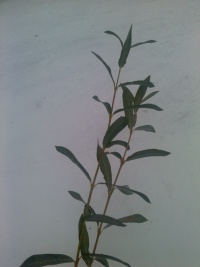Aravot
From Halachipedia
Revision as of 14:57, 4 October 2012 by YitzchakSultan (talk | contribs)
One of the four species mentioned in the Torah to be taken on Sukkot is ערבי נחל which are translated as the leafy branch of a specific type of willow tree. They are described by the torah as willows of the river because most of this species grows by the river.[1]
Signs of a Kosher Aravah
- The leaves are supposed to be long, narrow, and have a smooth edge. [2]
- Although the leaves usually have a smooth edge, if the edge has small bumps and is serrated like a small sickle it is nonetheless Kosher for the mitzvah. However, if the leaves are rounded, the edges are serrated like a saw, and the stem is white it is not Kosher for the mitzvah.[3]
- The stem is usually reddish.[4]
- Although most aravot grow by the water, aravot are Kosher anywhere they come from even if they grew in the desert. Some say it's preferable to take aravot that grew by a river, whereas others say that there's no preference.[5]
References
- ↑ The Pasuk in Vayikra 23:40 says one should take Arvei Nachal as part of the four species. The Rambam (Shofar VeSukkah 7:3) writes that since most of this species of willow grows by the river the Torah called it Arvei Nachal, a leafy tree that grows by the river.
- ↑ The Mishna (Sukkah 33b) writes that a safsafa is not Kosher in place of aravah. The Gemara 34a writes that the aravah has drawn out (long and narrow) leaves with smooth edges, whereas the safsafa has round leaves with serrated edges.
- ↑ Chazon Ovadya (p. 316)
- ↑ The gemara Sukkah 34a writes that the aravah's stem is supposed to be red as opposed to the safsafa (a pasul species similar to aravah) has a white stem.
- ↑
- The Briatta in the Gemara Sukkah 33b writes that although the Torah says arvei nachal, meaning a branch of a tree that grows by the river, since the word arvei is in plural it comes to include an aravah wherever it grew. The Rambam (Shofar VeSukkah 7:3) rules that an aravah is kosher wherever it grew even if it grew in the desert. S"A 647:1 codifies this halacha.
- Rashi (Sukkah 33b D"H Arvei) writes that while an aravah that grew by the water is preferable, one nonetheless fulfills his obligation with an aravah that grew elsewhere. Tosfot 34a D"H VeRabbanan says that the above Briatta was following Rabbi Akiva's opinion and the halacha doesn't follow Rabbi Akiva. The Rosh 3:13 writes that it seems that the Rif agreed with Tosfot because he didn't quote that Briatta as halacha. He continues that he didn't see people being careful about this issue insisting on having an aravah that grew by the water. He argues that even the other tenayim who don't hold like the Briatta agree that an aravah from anywhere is totally acceptable. The Tur 647 write that whereas most mefarshim say having an aravah that grew by the water is preferable, the Rosh and Rambam seem to hold that aravah wherever it grew is preferable.
- The Bet Yosef quotes Rav Eliyah Mizrachi who argues on the Rosh and Tur saying that the Rambam didn't mean an aravah from anywhere is preferable, but disagrees with him. He then quotes the Ran who supports the position of the Rosh. S"A quotes the language of the Rambam. Taz 647:2 goes so far as to suggest that it's better to take an aravah that didn't grow by the water so as to show the nuance of chazal in the pasuk (see also Gemara Brachot 38b. See, however, Ritva Yevamot 103b). The Mishna Brurah 647:3 writes that some say it's preferable to take aravah that grew by water, but the Taz disagrees. Kaf HaChaim 647:6 writes that although S"A rules that an aravah is preferable wherever it grew if it's possible one should try to satisfy all opinions by taking an aravah that grew by the water.
